
Pokémon is a series of video games developed by Game Freak and published by Nintendo and The Pokémon Company under the Pokémon media franchise. It was created by Satoshi Tajiri with assistance from Ken Sugimori, the first games, Pocket Monsters Red and Green, were released in 1996 in Japan for the Game Boy, later released outside of Japan as Pokémon Red Version and Blue Version. The main series of role-playing video games (RPGs), referred as the "core series" by their developers, has continued on each generation of Nintendo's handhelds. The most recently released core series games, Pokémon Scarlet and Violet, were released on November 18, 2022, for the Nintendo Switch.

Toki Tori is a puzzle-platform video game developed by Two Tribes and published by Capcom for the Game Boy Color. The game follows a young chick, Toki Tori, and his quest to rescue his younger siblings, still in their eggs. To progress through the game, the player must pick up each egg on a level using a set number of tools, with new tools being introduced as the player progresses through the four worlds. This usually involves careful planning and creative thinking.

Animal Crossing is a social simulation video game series developed and published by Nintendo. The series was conceptualized and created by Katsuya Eguchi and Hisashi Nogami. In Animal Crossing, the player character is a human who lives in a village inhabited by various anthropomorphic animals and can do various activities like fishing, insect catching, and fossil hunting. The series is notable for its open-ended gameplay and use of the video game console's internal clock and calendar to simulate real passage of time.

A Mii is a customizable avatar used on several Nintendo video game consoles and mobile apps. The name Mii is a portmanteau of "Wii" and "me", referring to them typically being avatars of the players. Miis were first introduced on the Wii console in 2006 and later appeared on the DS, 3DS, the Wii U, the Switch, and various apps for smart devices such as Miitomo. Miis can be created using different body, facial and clothing features, and can then be used as characters within games on the consoles, either as an avatar of a specific player or in some games portrayed as characters with their own personalities. Miis can be shared and transferred between consoles, either manually or automatically with other users over the internet and local wireless communications.

Boom Blox is a 2008 puzzle video game by Electronic Arts for the Wii and N-Gage. It was developed by EA Los Angeles and directed by filmmaker Steven Spielberg.
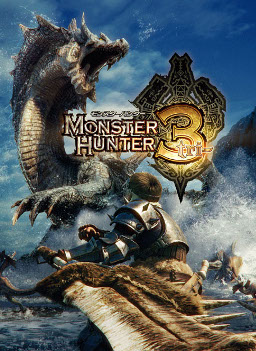
Monster Hunter Tri is the third console installment in the Monster Hunter franchise, developed by Capcom and released for the Wii in Japan on August 1, 2009. Monster Hunter Tri was released on April 20, 2010, in North America, April 23 in Europe, and April 29 in Australia.
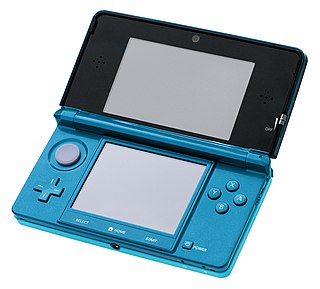
The Nintendo 3DS is a foldable handheld game console produced by Nintendo. The console was announced in March 2010 and unveiled at E3 2010 as the successor to the Nintendo DS. The system features backward compatibility with Nintendo DS video games. As an eighth-generation console, its primary competitor was Sony's PlayStation Vita.
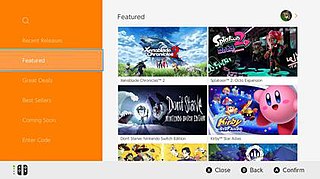
The Nintendo eShop is a digital distribution service for the Nintendo Switch, and formerly available via the Nintendo Network for the Wii U and Nintendo 3DS. The Nintendo eShop was first launched in June 2011 on the Nintendo 3DS via a system update that added the functionality to the HOME Menu. It is the successor to both the Wii Shop Channel and DSi Shop. Unlike on the Nintendo 3DS, the eShop was made available on the launch date of the Wii U, although a system update is required in order to access it. It is also a multitasking application, which means it is easily accessible even when a game is already running in the background through the system software, though this feature is exclusive to the Wii U and the Nintendo Switch. The Nintendo eShop features downloadable games, demos, applications, streaming videos, consumer rating feedback, and other information on upcoming game releases.

Super Smash Bros. for Nintendo 3DS and Super Smash Bros. for Wii U, both commonly referred to together as Super Smash Bros. 4, are 2014 crossover platform fighter video games developed by Bandai Namco Studios and Sora Ltd. and published by Nintendo for the Nintendo 3DS and Wii U video game consoles. It is the fourth installment in the Super Smash Bros. series, succeeding Super Smash Bros. Brawl. The Nintendo 3DS version was released in Japan on September 13, 2014, and in North America, Europe, and Australia the following month. The Wii U version was released in North America, Europe, and Australia in November 2014 and in Japan the following month.

Mighty Switch Force! is a puzzle-platform game developed by WayForward Technologies for Nintendo 3DS. It is the third game in WayForward's Mighty series, following Mighty Flip Champs! and Mighty Milky Way. The game was released on the Nintendo eShop on December 22, 2011. An update to the game, including five new levels, was released on May 24, 2012. A high-definition version, Mighty Switch Force! Hyper Drive Edition, was released for the Wii U in 2012, featuring re-drawn graphics and other new features. A Steam version of the game was also released in June 2015. A sequel, Mighty Switch Force! 2, was released in June 2013.

StreetPass Mii Plaza is an application which comes pre-loaded on all Nintendo 3DS systems. In the game, players can meet other players' Miis over StreetPass and online through Nintendo Network and interact with them.
The Nintendo Network was an online service formerly ran by Nintendo that provided free online functionality for the Nintendo 3DS and Wii U systems and their compatible games. Announced on January 26, 2012, at an investors' conference, it was Nintendo's second online service after Nintendo Wi-Fi Connection. Former president of Nintendo Satoru Iwata said, "Unlike Nintendo Wi-Fi Connection, which has been focused upon specific functionalities and concepts, we are aiming to establish a platform where various services available through the network for our consumers shall be connected via Nintendo Network service so that the company can make comprehensive proposals to consumers."
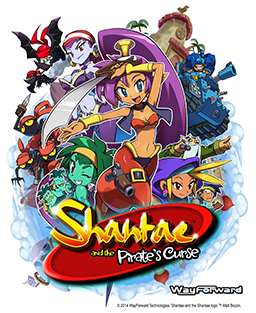
Shantae and the Pirate's Curse is a platform game developed by WayForward Technologies for the Nintendo 3DS and the Wii U. It is the third game in the Shantae series, following Shantae: Risky's Revenge, and the first to be developed for a home console. It was released in North America on the 3DS eShop on October 23, 2014 and on the Wii U eShop on December 25, 2014, and in PAL regions on both platforms on February 5, 2015. The game was later ported to PlayStation 4, PlayStation 5, Xbox One, Microsoft Windows, Amazon Fire TV, Nintendo Switch, and Amazon Luna. The game follows the adventures of the eponymous half-genie Shantae as she once again has to save Sequin Land from a new foe, the Pirate Master, with help from her nemesis Risky Boots.
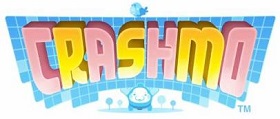
Crashmo is a puzzle video game developed by Intelligent Systems and published by Nintendo for the Nintendo 3DS as an Nintendo eShop exclusive. The game is a sequel to Pushmo and was released in Japan on October 31, 2012, in the PAL regions on November 15, 2012, and in North America on November 22, 2012.

Wii Party U is a party video game developed and published by Nintendo for the Wii U in 2013. It was announced in a January 2013 Nintendo Direct, and later detailed at E3 2013 and the October 2013 Nintendo Direct. It is the sequel to the 2010 Wii game Wii Party.

Pushmo World, known as Pullblox World in Europe and Australia and as Hikuosu World in Japan, is a puzzle game developed by Intelligent Systems and published by Nintendo for the Wii U video game console. The game is the sequel to Pushmo and Crashmo, and was released worldwide on June 19, 2014. A sequel, Stretchmo for the Nintendo 3DS, was released in 2015.

Mario vs. Donkey Kong: Tipping Stars is a 2015 puzzle-platform game developed by Nintendo Software Technology and published by Nintendo for the Nintendo 3DS and Wii U. It is the sixth game in the Mario vs. Donkey Kong series and the 200th video game featuring Mario. The game was released worldwide in March 2015 on the Nintendo eShop for all regions, and received a physical release in Japan. This is the first Nintendo-published title to support a cross-purchase concept; if players buy one version, they receive a free download code for the other version. The 3DS version is also the first Nintendo 3DS title to support Miiverse stamps.

Stretchmo, known as Fullblox in Europe and Australia and as Hikudasu Hippaland in Japan, is a downloadable puzzle game developed by Intelligent Systems and published by Nintendo for its Nintendo 3DS handheld system. The game is a sequel to Pushmo, Crashmo, and Pushmo World and was released on the Nintendo eShop.

Mario & Sonic at the Rio 2016 Olympic Games is a 2016 crossover sports and party game in the Mario & Sonic at the Olympic Games series, released for the Nintendo 3DS in February 2016 in Japan, March 2016 in North America, and in April 2016 for Europe and Australia, and for the Wii U worldwide in June 2016. The game is officially licensed by the International Olympic Committee, as are the other games in the series. It was developed by Sega, with assistance from Arzest and Spike Chunsoft, and published by Nintendo. It is the fifth title in the Mario & Sonic at the Olympic Games series. The game is a collection of Olympic sports themed mini-games featuring characters from the Mario series and the Sonic the Hedgehog series.


















